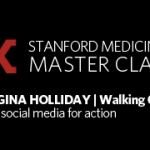Sonny Vu on the benefits and risks of health startups tapping the crowd for funding
Although crowdfunding has only been in our lexicon a short while, the financing model is rapidly gaining in popularity among both entrepreneurs and a wide range of investor types. The volume of money raised through crowdfunding sites, such as Kickstarter and Indiegogo, has grown from $900 million to about $2.7 billion in the past three years, according to the latest data from Statista. And, some have predicted that annual revenue from crowdfunding platforms could reach $6 billion in 2013.
Among the projects that proved to be tremendously successful through crowdfunding was Shine, an activity tracker device developed by Misfit Wearables. During a campaign last year on Indiegogo, the company quickly met its fund-raising goal of $100,000 and overall raised nearly $850,000. This fall at Medicine X, Misfit Wearable CEO Sonny Vu will teach a Master Class on crowdfunding for health where he’ll discuss what to do before launching a campaign and after it closes, as well as ways to maximize campaign appeal while it’s live.
In this Q&A, Vu explains why Misfit Wearables opted for the crowdfunding approach, how such campaigns can benefit startups seeking venture capital and risks and limitations of the financing model. Read on and then register to attend Medicine X and Vu’s Master Class this September.
It’s been reported that launching a crowdfunding campaign was contrary to then company’s original plans for how to introduce Shine. Why did the company decide to go this route?
The reasoning behind our crowdfunding campaign was to prove there was actually a demand for a product like Shine even before we produced it. Even though the landscape is still pretty open (there are only about 20-30 competitors in the market), it was an important step for us because we made some pretty bold design decisions and we wanted to make sure people wanted it. We chose Indiegogo for a number of reasons. Between the superiority of Indiegogo’s platform and the superiority of their service level/friendliness, there was much better support, frictionless payments and a fast growing audience. Most importantly, there was a purely meritocratic system vs. a system that was subject to inexperienced curators’ whims. Shine also did not satisfy Kickstarter guidelines because it’s a health and fitness product, which was disallowed. The Shine campaign was meticulously thought out ahead of time. It hit its funding goal of $100,000 within the first nine and a half hours and by the end of the campaign hit nearly $850,000. The funding came from supporters from 64 countries and all 50 states.
What were two of the most important lessons Misfit Wearables learned from the Shine campaign?
Keep it simple and be genuine.
How can a crowdfunding campaign strengthen a startup’s position when seeking angel investors or financing from venture capital firms?
As great as a product or device may be, it’s nothing if there is no demand for it. Crowdfunding is a one way to address this issue, especially when investors look to invest in products with an unproven potential. On top of that, the buzz generated from a popular crowdfunding campaign is invaluable. We were fortunate enough to get lots of positive coverage from the Indiegogo campaign, something many companies pay top dollar for and which we can’t afford as a cash-starved startup.
Recently, the crowdfunding space has grown to include health-care centric sites such as Medstartr and Health Tech Hatch. From your perspective, what are the pros and cons for a health-care startup in selecting a platform geared toward their specific industry versus a more traditional crowdfunding site?
As exciting as the development of health-care centric sites, such as Medstartr (which we love), those sites have less robust platforms and may only reach certain consumer segments. That said, the top campaigns do generate the majority of their own traffic. But the frictionlessness of the platform is also key — and this is something Indiegogo has mastered. The buying experience on Indiegogo is far better than Kickstarter’s. For Shine, which is a consumer-driven product, targeting a popular crowdfunding site such as Indiegogo was the right move.
What are some of the limitations and risks of the crowdfunding approach that health-care and biotech entrepreneurs should be aware in developing campaigns?
Health-care and biotech entrepreneurs need to be prepared to deliver what they set out to do. As supportive as crowdfunding communities are, they are equally critical of the products they support. So be ready to take the criticism. If you aren’t ready to deliver your product, you risk the chance of a lot of backlash. This is something that could really affect your reputation and credibility, so it’s important to have foresight into your delivery plan. Also, you have to be careful about not selling regulated products that have not been cleared by the U.S. Food and Drug Administration.
We’re honored to have Vu on our advisory board and are thrilled he’ll teaching a Master Class at Medicine X 2013.






